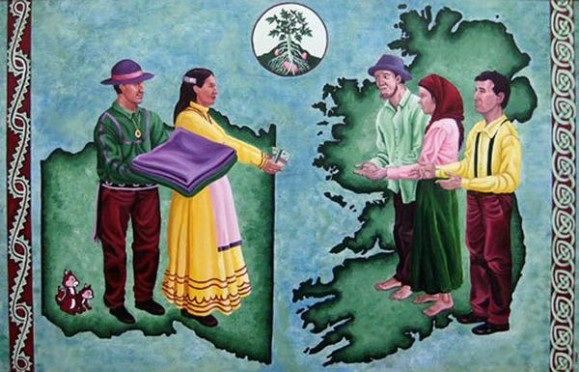The Choctaw Native American tribe and Irish people have a complex and nuanced relationship that has stretched across the centuries. Their histories of displacement and recovery inform and strengthen one another by providing a system of cooperation, generosity, and faith in the resilience of the human spirit. It was this connection that spurred the Queens Museum and Theatre to band together and celebrate the Irish and Choctaw people with an Irish-Choctaw Thanksgiving.
Eyewitness accounts of the Trail of Tears that the Choctaw had suffered through in many ways mimic those that came out of the Irish Famine. Ironically, it would be this event where the two people’s met. Upon hearing of the tragedy of the famine in Ireland, many Choctaw leaders banded together and raised $170 as a generous donation to the Irish people.
It is with this act of kindness in mind that the Queens Museum and Queens Theatre honored the Choctaw this past November 29 and 30th. All of the profits raised were split between Hour Children, Long Island City-based nonprofit that works with incarcerated and formerly incarcerated women and their children, and No Kid Hungry Share Our Strength, a nonprofit that connects children in need to nutritious food.
 The very special two day event was a cornucopia of movies, music, and laughter. Some of the highlights included performances by the Oklahoma Fancy Dancers, Darrah Carr Irish Dance, and Cruel Seamus at the Queen’s Theatre. Celtic Cross and singer/songwriter Deni Bonet performed to an enthusiastic crowd on Saturday night.
The very special two day event was a cornucopia of movies, music, and laughter. Some of the highlights included performances by the Oklahoma Fancy Dancers, Darrah Carr Irish Dance, and Cruel Seamus at the Queen’s Theatre. Celtic Cross and singer/songwriter Deni Bonet performed to an enthusiastic crowd on Saturday night.
Other standouts included the screening of the Choctaw Code Talkers which illuminated the role of Choctaw code breakers in WWII. Other films included The Native, Return to Sea, and A Pearl of Great Price.
The Choctaw, like the Irish have suffered through a rough history of disease, famine, rebirth, and integration. They banded together as a powerful Native American group in the 17th Century. Even though they were increasingly marginalized, they supported colonial independence during the Revolutionary War, and were later termed one of the “Five Civilized Nations” in the 19th century due to their adoption of many Anglo-American habits.
This unfortunately was unable to curtail the wave of westward expansion under the guise of Manifest Destiny headed by President Andrew Jackson. Beginning in 1831 through a series of unfair treaties, the Choctaw Nation were forced off of their land and further west into the desolate Oklahoma wild country. This episode is referred to as the “Trail of Tears” due to the treacherous weather conditions and severe loss of life. Alexis de Tocqueville, the influential French historian and philosopher was on hand to witness the tragedy, writing in his Democracy in America, “in the whole scene there was an air of ruin and destruction, something which betrayed a final and irrevocable adieu; one couldn’t watch without feeling one’s heart wrung.”
This same wringing of the heart has continued to strengthen the bond of the Irish and the Choctaws. Beginning in the 1990s, history and memory were united as a number of celebrations honored the role of the Choctaws in the Famine. Irish activists and Choctaw leaders took part in the first annual Famine walk at Doolough in Co. Mayo. This was later reciprocated with a 500 mile trek from Oklahoma to Mississippi in 1992. Then President Mary Robinson was also honored as a Choctaw Chief.
Queens Theatre and Museum tapped into the spirit of Thanksgiving by bringing these two people together once again in a heartfelt and memorable way.
* CORRECTION: An earlier version of this post misidentified the national affiliation of artist America Meredith. Meredith is a member of the Cherokee Nation, which also contributed to the relief effort of the Irish during the Famine.


I am engaged in writing a historical novel set in Ireland in the 1640′ and forward. Friends have told me that using Irish Choctaw interactions was just ‘artistic licence. this article validates my ersearch whic explores similarities of how both the Irish and the choctaw cultures were impacted by invaders. Please visit my site Breffni to Baltimore or faruark.blogspot;com
COMMENTS MORE THAN VERY WELCOMED.!
Fred